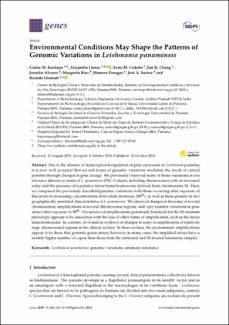| dc.contributor.author | Restrepo, Carlos M. | |
| dc.contributor.author | Llanes, Alejandro | |
| dc.contributor.author | Cedeño, Eymi M. | |
| dc.contributor.author | Chang, Jim H. | |
| dc.contributor.author | Álvarez, Jennifer | |
| dc.contributor.author | Ríos, Margarita | |
| dc.contributor.author | Penagos, Homero | |
| dc.contributor.author | Suárez, José A. | |
| dc.contributor.author | Lleonart, Ricardo | |
| dc.date.accessioned | 2020-06-13T04:45:17Z | |
| dc.date.available | 2020-06-13T04:45:17Z | |
| dc.date.issued | 2019-10-24 | |
| dc.identifier.other | doi:10.3390/genes10110838 | |
| dc.identifier.uri | http://repositorio-indicasat.org.pa/handle/123456789/58 | |
| dc.description | Due to the absence of transcriptional regulation of gene expression in Leishmania parasites, it is now well accepted that several forms of genomic variations modulate the levels of critical proteins through changes in gene dosage. We previously observed many of these variations in our reference laboratory strain of L. panamensis (PSC-1 strain), including chromosomes with an increased somy and the presence of a putative linear minichromosome derived from chromosome 34. Here, we compared the previously described genomic variations with those occurring after exposure of this strain to increasing concentrations of trivalent antimony (SbIII), as well as those present in two geographically unrelated clinical isolates of L. panamensis. We observed changes in the somy of several chromosomes, amplifications of several chromosomal regions, and copy number variations in gene arrays after exposure to SbIII. Occurrence of amplifications potentially beneficial for the Sb-resistant phenotype appears to be associated with the loss of other forms of amplification, such as the linear minichromosome. In contrast, we found no evidence of changes in somy or amplification of relatively large chromosomal regions in the clinical isolates. In these isolates, the predominant amplifications appear to be those that generate genes arrays; however, in many cases, the amplified arrays have a notably higher number of copies than those from the untreated and Sb-treated laboratory samples. | en_US |
| dc.description.abstract | Due to the absence of transcriptional regulation of gene expression in Leishmania parasites, it is now well accepted that several forms of genomic variations modulate the levels of critical proteins through changes in gene dosage. We previously observed many of these variations in our reference laboratory strain of L. panamensis (PSC-1 strain), including chromosomes with an increased somy and the presence of a putative linear minichromosome derived from chromosome 34. Here, we compared the previously described genomic variations with those occurring after exposure of this strain to increasing concentrations of trivalent antimony (SbIII), as well as those present in two geographically unrelated clinical isolates of L. panamensis. We observed changes in the somy of several chromosomes, amplifications of several chromosomal regions, and copy number variations in gene arrays after exposure to SbIII. Occurrence of amplifications potentially beneficial for the Sb-resistant phenotype appears to be associated with the loss of other forms of amplification, such as the linear minichromosome. In contrast, we found no evidence of changes in somy or amplification of relatively large chromosomal regions in the clinical isolates. In these isolates, the predominant amplifications appear to be those that generate genes arrays; however, in many cases, the amplified arrays have a notably higher number of copies than those from the untreated and Sb-treated laboratory samples. | en_US |
| dc.format | application/pdf | |
| dc.language.iso | eng | en_US |
| dc.rights | Info:eu-repo/semantics/openAccess | |
| dc.rights | https://creativecommons.org/licenses/by/4.0/ | |
| dc.subject | Leishmania panamensis | en_US |
| dc.subject | genomic variations | en_US |
| dc.subject | antimony resistance | en_US |
| dc.title | Environmental Conditions May Shape the Patterns of Genomic Variations in Leishmania panamensis | en_US |
| dc.type | info:eu-repo/semantics/article | en_US |
| dc.type | Info:eu-repo/semantics/publishedversion | |

